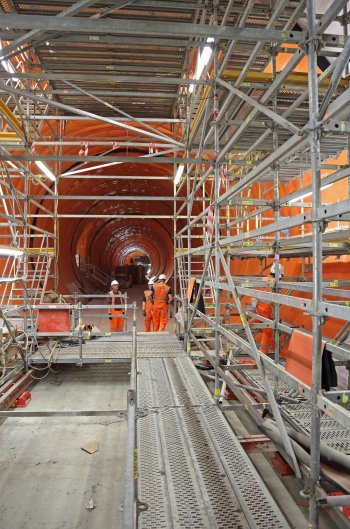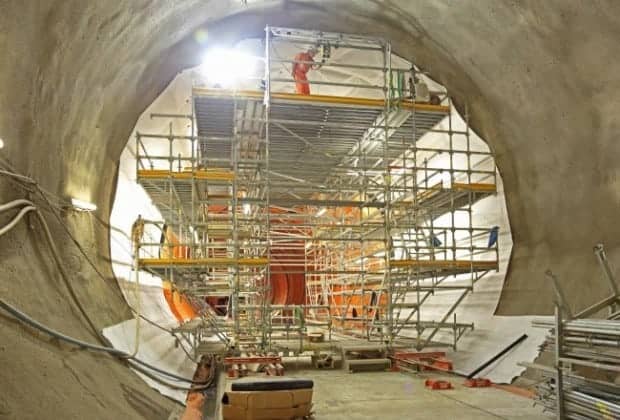PERI Ltd, the UK’s largest manufacturer of scaffolding and formwork, has provided significant time savings thanks to its unique scaffolding solution for the tunnel works on the Farringdon Station Crossrail project.
One of the most significant infrastructure projects to ever be undertaken in the UK, construction work on London’s ambitious Crossrail operation is 70% complete. Set to provide a quicker and more direct travel route across the capital, the new railway will be a high frequency, high capacity service linking 40 stations via 21km of new twin-bore tunnels under central London and the Docklands.

To construct the tunnels at Farringdon Station, mobile scaffolding with a diameter of more than 8m was required to enable both waterproofing and spray concrete lining. Additionally, the scaffolding design required access for trucks to enter the tunnel so concrete work could run simultaneously.
One of the challenges for PERI was to meet Prestec’s preference for a castor-mounted scaffolding structure, which significantly restricted the weight available for PERI and the contractor to work with. Also, the requirement for the scaffolding to enable concrete spray lining meant the structure would be too wide for movement along the tunnel.
PERI’s design team in Brentwood were able to tailor the PERI UP system so it could fit detachable cantilevered console brackets on the edges of the structure to allow waterproofing construction to take place. Once waterproofing was completed, the brackets could also be utilised for the concrete spraying, which enabled the work to be completed in a shorter period of time for the client.
Another major challenge for PERI’s design team was to incorporate the requirement for truck access. With safety and stability at the forefront of any construction project, PERI had to ensure that its scaffolding structure was meticulously designed to ensure worker safety, while also ensuring that it could be supported on the castors. The scaffolding was therefore designed with a passageway through the middle of the structure, which was a UK-first for PERI. The 4.4m high x 3m wide opening enabled the trucks to pass through without disrupting the waterproofing works.
Following the success of the PERI UP system on the castors, BFK extended the partnership with PERI to help completion of another section of the tunnel. For this section, BFK required the same system but in different sizes meaning PERI had to adapt the existing system to work on heavy-duty rollers. A combination of PERI’s Rail Climbing System (RCS) and VARIOKIT was utilised to allow an adjustable scaffolding system for the tunnelling.
Guillermo Lalinde, Section Engineer at BFK, commented: “The new system from PERI let us increase the width of the working platforms at different levels as weight was no longer a limiting factor. This reduced the time required to move the tower forward from one hour to 20 minutes, leading to an increase in production from five linear metres of tunnel per day to 12 linear metres.”
Neil Butlin, sales engineer at PERI Ltd, said: “Being involved with the Crossrail project posed significant challenges for PERI and we are delighted with the ongoing results. Introducing safe access stretching the whole circumference of the tunnel meant we had to design the PERI UP system in a way that has never been used before in the UK. The feedback from BFK has been great and we look forward to continuing this relationship on the Crossrail project.”
PERI’s involvement with the project will continue as they are now designing a system for construction of the escalator shafts. The new design will again use the combination of RCS, PERI UP and heavy-duty rollers but this time will see the system climb up the shafts. The construction work on the escalators is set to commence in February 2016 with the station’s final completion due in 2018.



Peri over layher any day